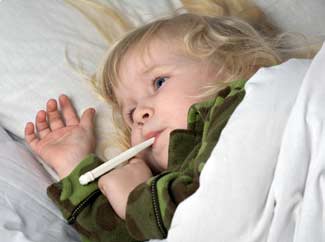Paracetamol
Paracetamol is an NSAID with stronger antipyretic and analgesic effect, but lack of anti-inflammation effect. This is the reason why paracetamol is mainly used as fever reliever and also as painkiller for children. It is an inhibitor of prostaglandin synthetase. This medicine has wide safety margin and less adverse effects on GI tract, so that it is considerably safe for children. Hepatotoxicity may occur when the maximum dose is exceeded or if paracetamol was consumed for a long time (more than several weeks).
Recommended dose for fever in children is about 10-15 mg/kgBW every 4-8 hours, with maximum dose of 4 gram/day.
Advantages: wider safety margin, less contraindications and adverse effects.
Disadvantages: weak anti-inflammation effect, cannot be given together with N-acetylcysteine (due to antagonism).
Suitable for: every degrees of fever in children especially in high-peak fever, mild pain reliever.
Ibuprofen
Ibuprofen is an NSAID with analgesic, antipyretic, and anti-inflammation effect. It works as a nonselective inhibitor of cyclooxygenase (COX) 1 and 2 enzymes; prolongs bleeding time and also has a reversible effect on platelet function.
Ibuprofen has slightly faster onset of action than paracetamol, but clinical effectiveness against fever is considerably equal with paracetamol. But there was a meta-analysis study has shown that ibuprofen effect on fever is superior than paracetamol, especially in the first 6 hours.
Ibuprofen also affects gastrointestinal system, which it can induce GI ulceration and bleeding. Due to these effects, ibuprofen's safety concern is higher than paracetamol, especially in children. When the fever does not resolve after 3-5 days, this medicine should be discontinued.
Recommended dose for fever in children is about 5-10 mg/kgBW every 6-8 hours. Theoritically this medicine can be used in every grade of fever, but practically this medicine is only used when fever peaks more than 38 degrees of Celsius.
Advantages: Quicker onset of action (about 20 minutes), stronger anti-inflammation effect.
Disadvantages: GI adverse effects, prolonged bleeding time, altered platelet function, not suitable for fever with GI complaints or dehydration.
Suitable for: relieving fever more than 38 degrees of Celsius, fever with predominant pain, fever without GI complaints.
Conclusion
- Against fever in children, paracetamol and ibuprofen have equal effectiveness, with a little favor of ibuprofen.
- Do not use paracetamol and ibuprofen concomitantly, unless both doses are diminished.
- Several countries have suggested that fever reliever should be used only in high-peaked fever, but some other countries have not.
- Since ibuprofen has faster onset against fever, ibuprofen should be "saved" only for high-peaked fever.
- Drinking a lot of water should be advised when your child is receiving paracetamol or ibuprofen.
- When the fever is not resolved after 3 days, contact your physician.
Your comments or experiences are welcome.
References:
Clinical Drug Data 11th edition, 2010
Perrott DA et al. Arch Pediatr Adolesc Med 2004; 158: 521-526.
Hay AD et al. BMJ 2008; 337: a1302
Using Paracetamol of Ibuprofen, Department of Health, Australia, 2007.


No comments:
Post a Comment